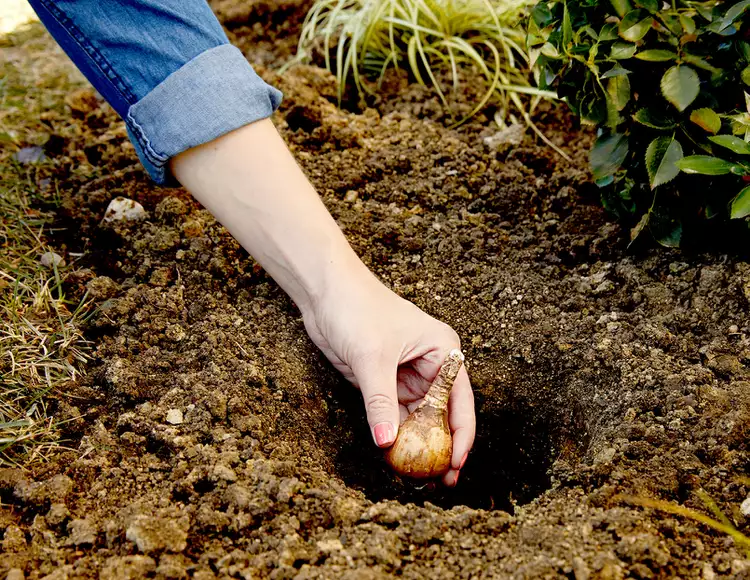How to Plant Spring Bulbs in Fall for Glorious Blooms Next Year

Bulbs are the closest thing you can get to guaranteed color. After getting them in the ground, all you have to do is sit back and wait for the show. All sorts of bulbs bloom at different times of the year, but the best to plant in fall for spring bloom include tulips, daffodils, grape hyacinth, crocus, and hyacinth.
These spring-blooming bulbs can be planted anytime in autumn until the ground freezes. They need several weeks of cold temperatures to grow correctly, so if you live where it stays warm year-round, buy pre-chilled bulbs and don't expect them to return after they bloom. These simple guidelines for how to plant spring bulbs will help you create a beautiful garden to enjoy next year.
How to Plant Single Bulbs
A good rule of thumb is to plant bulbs three times as deep as the bulb is tall. For example, if a bulb is 3 inches tall, dig the hole 9 inches deep. A hand trowel works well to dig a hole at the appropriate depth for your bulb. Some garden trowels ($12, Lowe's) even have measurements marked to help you know when you've dug deep enough.
Place the bulb in the hole pointy side up, with the roots facing down. Don't worry if your bulb ends up a little sideways because most will still find their way to the surface once they start growing. Fill in the hole again to cover the bulb, then water to get it growing.
Test Garden Tip: Covering your newly planted area with protective mesh-like chicken wire will help deter squirrels, chipmunks, and other garden creatures from digging up and eating your bulbs. Or choose bulbs that animals tend to leave alone, such as daffodils, alliums, and snowdrops.
Planting Multiple Bulbs
When you've got lots of bulbs to plant over a large, open area like a new flower bed, use a spading fork or small tiller to loosen the soil first. Freshly-tilled soil will make it much easier to plant your bulbs. Once you've prepped your soil, lay out your bulbs so they are at least 4 inches apart. You can plant them in rows for a more formal look or in small groups of odd numbers for a more natural look. When you have all your bulbs arranged the way you want, plant each bulb as you would if you were planting them on their own, using a trowel to place it three times as deep as the bulb is tall.
Test Garden Tip: For a less formal display, look for naturalizing mixtures of bulbs (a mix of varieties), which can be cheaper than buying each type of bulb separately and mixing them yourself.
Pairing Bulbs and Perennials
Planting spring-blooming bulbs around established perennials is a smart strategy for concealing bulb foliage when it starts to die back after blooming. While this is happening, many perennials like ferns and hostas will send up fresh, new growth that will help hide the less-than-lovely bulb foliage.
When planting bulbs among your perennials, a long-handled bulb planter is a great tool for getting into tight spaces where there's little room to dig or avoid stepping on plants. If you have larger spots between perennials, try digging a wider hole with a shovel and layering different-sized bulbs in it to create even more eye-catching pops of color. Place your bigger bulbs like daffodils and hyacinths first, then fill to the correct depth for smaller bulbs like crocus and squill.
Test Garden Tip: Bulbs need their leaves to make energy to fuel next year's growth, so wait to clean up the foliage until it has completely turned yellow or withered.
How to Replant Bulbs
Some bulbs will reliably come back year after year without replanting, such as daffodils, as long as they have the right weather conditions (most bulbs need a period of cold weather to bloom, so if you live in an area with warm winters, you might need to dig up and chill your bulbs indoors to get them to rebloom). The bulbs you can usually count on to rebloom without needing to plant more are alliums, crocuses, daffodils, Siberian squill, and snowdrops.
Others will rebloom for a few years with the right conditions but eventually stop producing, including hyacinths, crown imperials, grape hyacinths, and reticulated iris. For guaranteed blooms each year, you'll probably want to plant a few more of these bulbs every fall (you can never have too many!). Finally, some bulbs are best treated as annuals that need to be replanted yearly, including tulips, freesia, Dutch iris, and ranunculus.